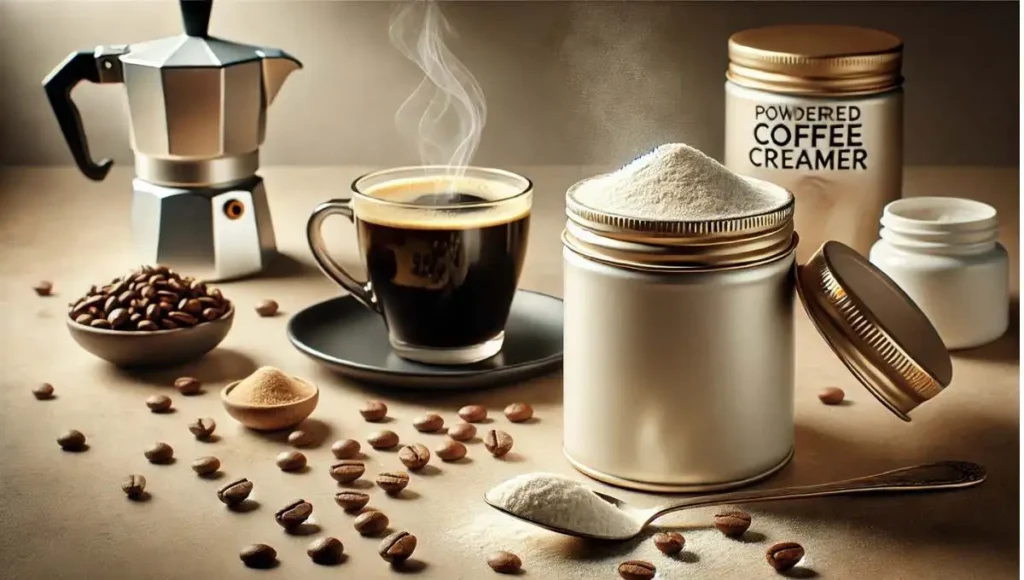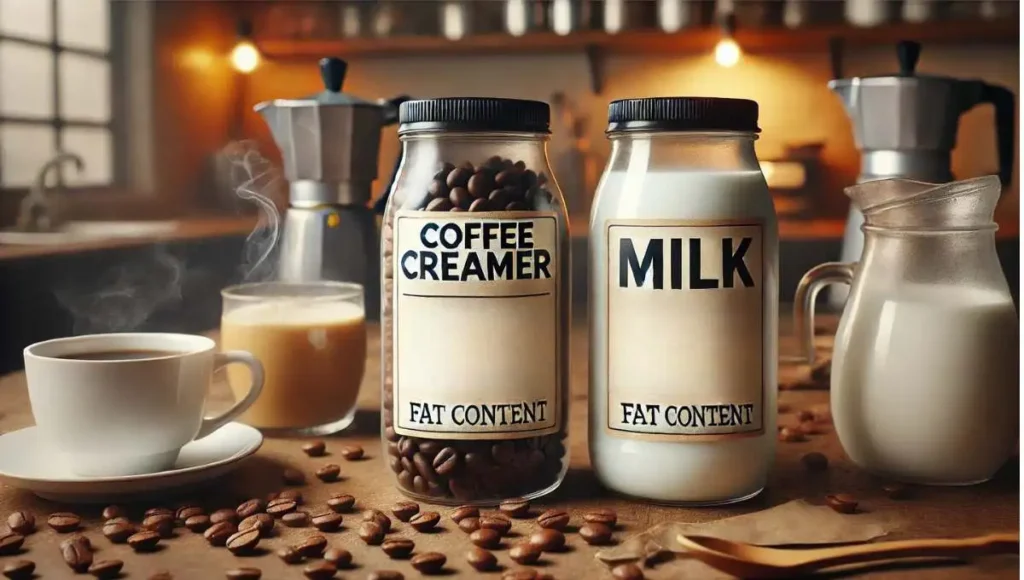When you’re looking to enhance the flavor of your coffee or tea, coffee creamer can be a great alternative to milk or cream. It not only lightens the color of your drink but also adds a rich, creamy texture that transforms your regular hot drinks or iced drinks into something special.
Whether you’re trying to avoid dairy or simply experimenting with new flavors, a splash of creamer can give your cup that extra indulgent touch. Plus, if you’re someone who enjoys whipping your creamer into foams, it’s a perfect way to get that frothy finish, making your coffee feel like a special treat.
For those mornings when you’re in need of a richer and creamier taste but have run out of milk, coffee creamer works wonders. Its smooth texture and versatile nature make it ideal for replacing milk.
However, keep in mind that coffee creamer often has a slightly different taste due to its blend of water, sugar, and vegetable oil, unlike milk that comes from cows or other animals. Whether you prefer a traditional taste or enjoy adding a unique twist to your drinks, coffee creamer can be an exciting option. It’s perfect for desserts, baking, or even a morning cup of coffee if you want to try something new.
What is Coffee Creamer?
Coffee creamers, also known as coffee whiteners, are popular substitutes for milk when you want to add some lightening to your coffee drinks. They come in various forms, such as liquid, powdered, and refrigerated. Non-dairy versions are made from ingredients like vegetable oils and sugar, which means they don’t contain lactose.
These creamers often mimic the texture of half-and-half, and you can even find flavored varieties like French Vanilla or Irish Crème. Some powdered creamers are dehydrated powder that turns into a liquid creaminess when mixed with water, while refrigerated liquid creamers often contain at least 10% milk products like skim or whole milk. These creamers can spoil like regular dairy milk.
People use coffee creamers for several reasons: to avoid fats, manage lactose intolerance, enjoy the preference for extra sweetness, and benefit from the convenience and shelf stability of creamers. If you’re looking for a richer or more indulgent coffee, these creamers are a versatile option.
They can also help replicate the texture of milk with a few small adjustments, making them great for anyone experimenting with their coffee routine or managing dietary restrictions.
Coffee Creamer as Milk Substitute!
Ingredients
- Water
- Sugar
- Vegetable oil
- Artificial flavors
- Preservatives
- Thickeners
- Soy (for non-dairy options)
- Almond (for non-dairy options)
- Coconut milk (for non-dairy options)
- Milk (for dairy-based creamers)
- Cream (for dairy-based creamers)
- Hydrogenated vegetable oil (specific to Coffee-Mate)
- Corn syrup solids (specific to Coffee-Mate)
- Sodium caseinate (specific to Coffee-Mate)
Can You Substitute Coffee Creamer For Milk?
Yes, coffee creamer can generally substitute for milk in many recipes, particularly for adding creaminess and flavor. However, be aware it’s not a perfect one-to-one replacement due to differences in sweetness, fat content, and texture. Creamers can significantly alter the taste profile of dishes like soups, sauces, or delicate baked goods. Start with smaller amounts and adjust carefully.
Non-Dairy and Dairy-Free Options
If you’re lactose intolerant, following a vegan lifestyle, or simply prefer a dairy-free diet, non-dairy creamers are an excellent choice. These creamers are typically made from plant-based ingredients such as soy, almond, and coconut milk, which provide a smooth and creamy texture without any dairy products.
You can find them in a range of delicious flavors, including hazelnut, vanilla, and caramel, giving your coffee a unique taste. Whether you’re looking for a quick substitute or a way to enhance your coffee, these plant-based options make for a great alternative.
In addition to being a perfect choice for those avoiding dairy, these creamers also bring a unique flavor to your coffee. With varieties such as soy, almond, and coconut milk, you can easily find the right one that suits your taste. The creamy texture they offer can match that of milk, making them a viable option if you’re looking to replace milk in your coffee.
Whether you’re choosing a non-dairy option for dietary reasons or just to try something new, these creamers are versatile and can elevate your coffee experience.
Flavors
Flavored coffee creamers are a popular choice for those who want to add a unique taste to their coffee. These creamers come in a variety of flavors, such as vanilla, hazelnut, caramel, and even pumpkin spice.
They offer both dairy and non-dairy options, making them a great substitute for milk. Whether you’re craving something sweet or indulgent, flavored coffee creamers can help enhance the flavor of your coffee. If you’re looking for a non-dairy alternative, you can find flavored creamers made from plant-based ingredients to suit your preferences.
From vanilla to hazelnut, and even seasonal options like pumpkin spice, these flavors will surely enhance your coffee experience. Whether you prefer a creamy, rich cup or something lighter, flavored coffee creamers provide the perfect addition to your coffee routine.
Powdered Coffee Creamer
Powdered coffee creamer is a convenient and long-lasting option for those who want to enjoy creamy coffee without the need for refrigeration. Made from dried milk, sugar, and vegetable oil, along with other additives, it’s an easy-to-store solution. Whether you’re on camping trips or on the go, powdered coffee creamer comes in a variety of flavors and offers a practical choice for adding that creamy texture to your coffee anytime.

For anyone looking for a long-lasting coffee companion, powdered coffee creamer can be a reliable addition to your routine. It’s especially useful when you’re traveling, camping, or simply need a non-perishable option that doesn’t require refrigeration. With a range of flavors to choose from, it’s easy to enjoy a rich, creamy coffee experience wherever you are.
Artificial Flavors and Preservatives
Some coffee creamers may contain artificial flavors and preservatives that are added to enhance their taste and shelf life. While these additives are generally regarded as safe, it’s important to read the labels carefully and opt for creamers made with natural ingredients if you have any concerns about consuming artificial additives.
This way, you can make a more informed choice and select a creamer that aligns with your dietary preferences.
By choosing natural ingredients, you can avoid unnecessary artificial additives while still enjoying a flavorful coffee experience. Keep an eye on the labels to ensure the creamers meet your taste and health expectations.
Labels
When choosing a coffee creamer, it’s important to check the labels carefully to ensure it meets your dietary needs and preferences. If you’re lactose intolerant, following a vegan diet, or looking for non-dairy options, make sure to look for creamers that are labeled as dairy-free or vegan. Pay attention to the ingredients list for potential additives or allergens that you might want to avoid.
Whether you’re choosing flavored creamers or powdered creamers, reading the label ensures you are selecting the right option that aligns with your dietary preferences, making the substitute process smooth and tailored to your needs.
Coffee Creamer vs. Milk: Key Differences

When choosing between coffee creamer and milk, the differences are clear. Coffee creamer is often a highly processed product that contains sugar, artificial ingredients, and is designed to provide a sweet flavor and a creamy texture to your coffee.
On the other hand, milk is a natural dairy product with minimal processing, offering nutritional value such as protein, calcium, and additional nutrients that contribute to your overall health.
While creamer gives your coffee a rich, indulgent taste, milk provides a more neutral taste and is a source of minerals like potassium, making it a better option for those looking for a balanced beverage. Creamer is typically sweetened, thicker, and creamier, while milk has less fat, less sugar, and delivers a more nutritional profile.
How Much Coffee Creamer Equals Milk? Ratio Equivalencies
When substituting coffee creamer for milk, it’s essential to keep in mind some rough measurements for common ratios.
| Milk Type | Powdered Creamer (Tbsp) | Water (Tbsp) | Liquid Coffee Creamer (Tbsp) |
| Half and Half | 1 | 1 | 2 |
| Whole Milk | 2 | 2 | 4 |
| 2% Reduced Fat Milk | 3 | 3 | 5 |
| Skim Milk | 4 | 4 | 8 |
| Comparison (1/4 cup Whole Milk) | 3 | N/A | 8 |
However, it’s always best to adjust according to your taste preferences. Start with a smaller amount to avoid an overpowering flavor, and be cautious of curdling or bitterness if the creamer is overheated in coffee. This flexibility allows you to enjoy a customized cup that meets your flavor and strength preferences.
Nutritional Differences Between Milk and Coffee Creamer
When you’re thinking about substituting milk with coffee creamer, it’s important to keep in mind some nutritional factors. Milk is a natural drink packed with essential nutrients like calcium, protein, and vitamins that our body needs to stay healthy.
On the other hand, coffee creamer is a processed product that often includes added sugars, additives, and preservatives, which might make it less nutritious.
While it can offer a creamy texture and a bit of sweetness, it’s typically lower in nutrients compared to milk. If you’re switching, it’s worth considering these differences to make sure you’re not missing out on the nutrients that milk provides.
Fat and Calories
When you’re considering using coffee creamer as a substitute for milk, it’s important to think about the fat and calories content. Whole milk is a good source of healthy fats, providing around 150 calories and 8 grams of fat per one cup.
In comparison, coffee creamer tends to be much higher in calories and fat, with some types containing up to 50 calories and 5 grams of fat per serving.
While it might seem like a small difference, if you’re trying to control your calorie intake, these variations can add up. Personally, I’ve noticed that coffee creamer can significantly change the richness of my coffee, but it’s something to keep in mind if you’re watching your fat or calories.
Sugar
When you consider substituting milk with coffee creamer, the calories and fat content are worth noting. Milk is a great source of healthy fats and provides about 150 calories and 8 grams of fat in a single cup of whole milk. In contrast, coffee creamer is often much higher in calories and fat, with some varieties offering up to 50 calories and 5 grams of fat per serving.
This means that depending on the type of coffee creamer, you could be adding more calories or fewer calories than you would with milk. It’s always a good idea to check the label to see exactly what you’re getting.
Protein, Vitamins, and Minerals
When thinking about substituting milk with coffee creamer, the protein, vitamins, and minerals play a key role. Milk is a rich source of protein, with one cup of whole milk containing around 8 grams of protein. It also provides significant amounts of essential nutrients like calcium, vitamin D, and vitamin B12.
On the other hand, coffee creamer is typically low in protein and often lacks the important vitamins and minerals found in milk. So, if you’re looking to get these nutrients, milk is the better choice in your coffee.
Saturated Fat
When substituting milk with coffee creamer, another important factor to think about is the amount of saturated fat in the product. While milk naturally contains some saturated fat, many types of coffee creamer have added saturated fat from hydrogenated oils, which could increase your risk of heart disease.
So, if you’re using coffee creamer as a substitute for milk, it’s essential to be aware of the fat content. In summary, coffee creamer can be a convenient alternative, but it’s often a processed product that is high in calories, sugar, and fat. If you decide to use coffee creamer, make sure to read the label carefully and choose one that is low in sugar and saturated fat.
Can Creamer Be Healthier Than Milk?
When you think about substituting milk with coffee creamer, it’s important to consider how the fat content can affect your health. While some coffee creamers are high in fat and can increase your risk of certain diseases, the good news is that you can find coffee creamers that are low in fat and sugar to suit your diet.
If you’re looking for a healthier choice, 1% milk or half and half milk is a better option than coffee creamer. These options are less processed and contain more essential minerals and vitamins that are good for your health.
Using Coffee Creamer in Beverages

Coffee creamer is a popular addition to coffee, but can it be used as a substitute for milk in other beverages? The answer is affirmative, but there are a few important considerations. While it can work in most drinks, it might not offer the same nutrients or texture as milk, so it’s worth considering the kind of beverage you’re making and what you want from your substitute.
How to Use Coffee Creamer in Tea
Coffee creamers can also serve as a replacement for milk and dairy in tea. To get the best results, follow these simple tips: First, stick to small amounts since tea flavors are subtle. Powdered creamer blends most easily, so add it just after the tea bag is removed.
Make sure to agitate gently while dissolving the powder. Start with just 1-2 teaspoons and adjust according to your taste preferences. This method works great for chai tea lattes and bubble tea too!
Can You Add Coffee Creamer to Green Tea?
You can certainly add coffee creamer to green tea if you like, but this decision will come down to personal preference. Keep in mind that along with altering the taste of the green tea, adding creamer may also change some of the health benefits.
This is especially important if you mainly drink green tea for its health benefits, such as the catechins found in it, which are beneficial for the heart and blood vessels. Adding creamer may reduce these benefits, so it’s something to consider.
Tea and Hot Chocolate
If you’re considering using coffee creamer as a substitute for milk in tea or hot chocolate, it’s definitely possible, but there are a few things to keep in mind. Adding creamer will alter the taste and texture of your beverage, as it often has a richer and creamier consistency than milk. Some creamers are flavored, which can give your drink a unique twist, depending on the flavor you choose.
However, if the creamer is too thick or sweet, it may overpower the delicate flavor of your tea or the rich taste of your hot chocolate, so it’s important to use just the right amount.
I’ve tried coffee creamer in both tea and hot chocolate, and while it can work well, I find that you need to adjust the quantity based on how sweet or thick the creamer is. Too much, and it can completely change the flavor profile of your drink, but with the right balance, it can be a great alternative to milk.
Smoothies
If you’re considering substituting coffee creamer for milk in your smoothies, it’s possible, but there are a few things to keep in mind. While creamers can make your smoothie creamy and add some extra richness, they are often high in sugar and fat, which may make the smoothie less healthy. Creamers may also not blend as well with the other ingredients, possibly leaving behind a lumpy texture.
You can choose from flavored or unflavored options, depending on what you’re going for, but it’s important to consider these factors before making your decision. So, while coffee creamer is an easy substitute for milk, it may not always provide the same nutritional benefits that milk does.
Almond Milk and Milk Tea
If you’re wondering whether coffee creamer can replace milk in drinks like almond milk or milk tea, the answer is a bit tricky. While it’s true that coffee creamer can be used as a substitute, it won’t exactly mimic the same results. Almond milk, with its nutty flavor, brings a unique taste that creamer just can’t replicate.
On top of that, milk tea has its own distinct taste, and adding creamer may end up altering that flavor. The texture might also feel different since creamer doesn’t have the same consistency as milk, which could make your drink feel a bit off. So, while creamer can work in a pinch, don’t expect it to provide the same experience, especially if you’re after that classic milk-based drink.
Not all substitutes are perfect, but in some cases, it can still be a viable option, especially if you’re okay with a slightly different taste or texture. However, if you’re looking to preserve that authentic flavor, it might be best to stick with milk or almond milk.While it’s an option, it’s important to consider how the creamer may change the overall experience of these beverages.
Latte and Espresso
When it comes to lattes and espresso, coffee creamer can serve as a substitute for milk, but it may not deliver the same results. The foam and texture of a latte or espresso are essential elements of the experience, and creamer often fails to create the desired frothiness.
Creamers tend to be thicker, which means they can’t replicate the light, airy texture that makes a latte or espresso so special. While it can still work in your cup, the same smoothness and delicate foam won’t be quite there. If you’re after that signature texture in your coffee drinks, milk or a lighter alternative might be your best bet.
So, while it’s a viable option, it may not achieve the same result as milk in these drinks.
Coffee Drinks
When using coffee creamer as a substitute for milk in your coffee drinks, you might notice a shift in both the taste and texture. Some creamers come with added flavors, giving your coffee a unique taste that’s different from the standard, smooth flavor of milk.
However, if the creamer is too thick or sweet, it could easily alter the natural flavor of the coffee and overpower the richness you love. The texture might also change, as creamer doesn’t always blend the same way as milk, leaving your drink feeling heavier or less smooth. So while it’s a good alternative in a pinch, the overall experience might differ from what you’re used to with milk.
When using creamer as a substitute, it’s important to consider the flavor and texture of the creamer and how it will interact with the other ingredients.
Is Adding Creamer to Coffee Bad?
Coffee creamer is best viewed as an indulgent treat rather than something you use in coffee all the time. While it’s helpful to know how to make coffee with creamer instead of milk, it’s important to consider the impact of regular consumption.
Using coffee creamer too often can increase your risk of consuming excess sugar, fat, and calories, which might negatively affect your health over time. Many creamers are laden with added sugars and artificial ingredients that can lead to weight gain or other health issues if consumed excessively. So, while the substitute may work as a quick fix in your daily routine, it’s worth weighing the long-term effects on your health.
So stroke, diabetes, and heart disease can occur due to the high fat content. It’s recommended to consume no more than two grams of trans fat per day, and some coffee creamer brands contain one gram of trans fat in just one tablespoon. This makes it crucial to be aware of the ingredients in your creamer and adjust your diet accordingly.
Overconsumption of trans fat can have serious health consequences, so understanding what’s in your coffee creamer and how it fits into your daily intake is essential for maintaining a healthy lifestyle. Being mindful of these factors will help you make more informed choices when using creamer as a substitute for milk.
Using Coffee Creamer in Cooking and Recipes
If you’re out of milk but still want to add a creamy texture to your breakfast or any other dish, coffee creamer can be a great alternative. It’s incredibly versatile and works well in a variety of recipes, not just for your morning cup of coffee.

For instance, you can use coffee creamer in waffles or pancakes, mixing it into the batter for a smoother, richer texture. It can also be a handy substitute when you’re baking or cooking. If you need an extra creamy touch, try adding flavored coffee creamer like vanilla or cinnamon to give your dishes an unique flavor and make them more flavorful.
When it comes to savory recipes, unflavored coffee creamer can be just as useful. It works wonders in dishes like soups and mashed potatoes, adding a creamy richness and making them feel more indulgent.
But do keep in mind that the sweetness and the creaminess of the creamer can alter the flavor profile of the dish, so you might want to experiment a bit before you go all-in. This small new twist could bring a lot of exciting changes to your cooking, especially when you’re looking for that extra creamy finish.
Baking and Desserts
Coffee creamer can be a great substitute for milk in various baking recipes like cakes, muffins, and cookies. However, since coffee creamer is often sweetened, you may need to adjust the sugar amount in the recipe.
For instance, if the recipe calls for 1 cup of milk and 1/2 cup of sugar, you may want to reduce the sugar to 1/4 cup when using sweetened coffee creamer. This ensures the taste stays balanced and not overly sweet.
Additionally, the flavor of the coffee creamer plays a significant role in your baking. Flavored coffee creamers like vanilla or hazelnut can enhance the overall flavor of the dessert. For example, vanilla-flavored coffee creamer pairs wonderfully with vanilla cakes or cookies, while hazelnut-flavored creamer can add a delicious twist to chocolate desserts.
So, when using coffee creamer in baking, be mindful of both the sugar content and the flavor to get the best results.
Breakfast Foods
When whipping up breakfast foods like pancakes, waffles, or even a bowl of cereal, swapping milk with coffee creamer can add a delightful twist. I’ve found that coffee creamer brings a creamy and rich texture to dishes, but it’s important to note that it’s often sweeter than regular milk. This means you might need to adjust the sweetness in your recipe.
For example, when making pancakes, if you’re using sweetened coffee creamer, consider reducing the sugar in the batter to maintain the right balance of flavor. Similarly, for waffles, the creamer can enhance the richness, but you may need to tweak other ingredients to ensure the dish isn’t overly sweet. It’s all about experimenting and finding the perfect harmony for your taste buds!
Waffles and Pancakes
If you’re looking to elevate your pancakes or waffles, try replacing some of the water or milk in your mixture with half a cup of coffee creamer. This simple swap adds a stunning flavor to the mix, and if you’re feeling adventurous, opt for flavored coffee creamers like cinnamon or mocha for an even better flavor.
Personally, I’ve found that mixing the batter as usual and cooking it in a waffle machine or a frying pan to flip those golden pancakes creates a deliciously rich and aromatic breakfast. It’s a minor adjustment that can make a significant impact!
Mashed Potatoes
When thinking about alternative ways to create creamy and flavorful dishes, one interesting substitution idea is using coffee creamer instead of milk in recipes like mashed potatoes. This may seem unusual, but it can add a unique twist to your cooking. For best results, it’s important to use unsweetened coffee creamer to avoid unwanted sweet flavors in your savory dishes.
Adding coffee creamer to mashed potatoes can give them a deliciously creamy texture and enhance their flavor. However, be mindful to not use sweetened creamer, as it might not pair well with the savory nature of the potatoes. This handy trick is perfect for those looking to experiment in the kitchen while achieving a delightful result.
You might be surprised, but coffee creamer isn’t just for desserts! Adding half a cup of unflavored coffee creamer to mashed potatoes can give them a gorgeous texture. This ideal alternative works well for those who are lactose intolerant, as most creamers are lactose-free. It’s a simple trick that elevates the creamy goodness of your mashed potatoes without the need for traditional dairy products.
Sauces and Pasta Sauces
One creative idea to enhance sauces and pasta dishes is by using coffee creamer. Adding creamer gives the sauce a creamy texture and a subtle hint of flavor. It’s important to use unsweetened creamer to maintain the balance, and you may need to adjust the other flavors accordingly. This simple swap can elevate your dishes while providing a deliciously creamy touch.
Frostings and Glazes
You might not have considered it before, but coffee creamer can work wonders in frostings and glazes for cakes and other baked goods. To get the best results, it’s important to think about the flavor of the creamer and adjust the sweetness of your recipe accordingly.
Overall, coffee creamer can be a fantastic substitute for milk in many recipes, as long as you keep the sweetness and flavor in mind and adjust the recipe as needed..
Cake Icing
A delightful way to incorporate coffee creamer while baking is to mix it into your cake icing. Simply whip up some creamer in any flavor you like and add icing sugar to create a sweet and simple icing for cupcakes and more. For a thinner ganache, add more sugar and reduce the amount of creamer, achieving a lovely drizzle effect.
Creamy Soups
Incorporating unflavored coffee creamer into savory recipes is another way to create a creamy soup. If you’re making soup and need to thin it out or make it creamier, simply add coffee creamer. This method works best with creamy soups like mushroom, broccoli, or potato soup.
Depending on the amount of soup, add half a cup to two cups of coffee creamer, slowly mixing it in. For an extra twist, you can use spiced creamer for even more flavorful results.
Breakfast Bowls
If you like making Insta-worthy breakfast bowls, adding creamer will enhance the texture of the bowl along with adding more flavor to your oatmeal. You can easily incorporate coffee creamer into oatmeal and breakfast cereals to boost the flavor.
Just reduce the amount of milk you would normally use and replace it with creamer. For an extra burst of taste, opt for a flavored creamer like cinnamon or vanilla.
Fruit Salad Dressing
For a healthier dessert like fruit salad, coffee creamer can add sweetness and indulgence. Simply cut up some fruits of your choice and drizzle with creamer. You can whip it up, soak the fruit in it, or let it sit in the refrigerator while. Sour strawberries work amazingly with sweet creamer. Coffee creamer is also useful in baking, cooking, and even tea or hot chocolate. It’s typically lactose-free, making it suitable for people with allergies to milk.
- Does NOS Energy Drink Have Caffeine? Expert Guide (2025)
- Does Bubbl’r Sparkling Water Have Caffeine? Full Breakdown In 2025
- Does Elderberry Energy Drink Contain Caffeine? Complete 2025 Review
Customizing Coffee Creamer for Your Needs
When substituting coffee creamer for milk, it’s important to consider the flavor and texture impact. Creamers can add a creamy and indulgent touch to your coffee but may alter the taste and texture in ways that might not be desirable.
Some creamers are thick and heavy, making the drinking experience less enjoyable. Select a creamer that adds a smooth, creamy texture without making your coffee overly thick.
Hazelnut and French vanilla creamers add a flavorful touch, but it’s crucial they complement rather than overpower your coffee. Avoid those with artificial flavors that detract from the overall taste.
If you prefer a rich coffee, try sweet or sour cream as a substitute, but remember it may alter the flavor and texture significantly. Use a small amount to keep the creamy texture balanced. By considering these factors, you can enjoy a delicious and satisfying cup of coffee with your preferred creamer substitute.
Customizing Your Cream and Sugar Ratio
Everyone’s preferences differ when it comes to achieving an ideal balance of cream and sugar. Follow these general tips when substituting coffee creamers: Add the creamer before any sugar or sweeteners.
Pour the creamer slowly into piping hot coffee while stirring. Slowly add more if necessary to achieve the desired level of richness.
Sweeten after reaching the preferred creaminess. Agitate but avoid over-mixing once the sweetener is incorporated.
Substitute Less Fat Creamers and Milk For
Heavy cream can be substituted for foams or whipped options using powdered creamer or sweetened condensed milk.
- For whole milk, use flavored or French vanilla liquid coffee creamers.
- 2% reduced fat milk can be swapped with plain refrigerated liquid coffee creamers.
- When it comes to skim milk, opt for powdered non-dairy creamer dissolved in water.
- Lastly, for non-dairy milk, try using refrigerated non-dairy flavored creamers.
Lactose Intolerance and Dairy Allergies
For individuals who are lactose intolerant or have a dairy allergy, coffee creamer can be an excellent alternative.Most coffee creamers are lactose-free and do not contain any dairy products. However, it’s crucial to check the label carefully to make sure the creamer contains no dairy ingredients.
Non-Dairy Creamers
If you’re looking for a dairy-free option, non-dairy creamers are a great way to add some extra flavor to your coffee. These great options are made from a variety of ingredients like coconut milk, almond milk, and soy milk. They come in different flavors, allowing you to customize your coffee experience.
Coffee Creamer for Allergies
One great reason to use coffee creamer instead of milk is when you’re cooking for somebody with a dairy allergy. Since many coffee creamers are dairy-free, they become an ideal choice for those with dietary restrictions. Along with being dairy-free, lots of creamers are also gluten-free, making them perfect for guests with a gluten allergy.
I’ve found that when I’ve forgotten to buy special milk for a guest, reaching for my coffee creamer has saved me a trip to the store. It’s a simple solution that ensures everyone can enjoy their coffee without worry.
Creative Uses for Coffee Creamer
Don’t let leftover coffee creamer go to waste! There are some creative ways to use that opened creamer in your kitchen:
- Mix it with granola, berries, or other fruit to create a delicious salad dressing for a fresh fruit salad.
- Make your oatmeal, grits, or cereal creamier by adding creamer.
- Add richness and flavor to recipes like sweet potato pie.
- Use creamer in place of milk for cream-based soups, enhancing texture and taste.
- Blend it into smoothies, milkshakes, or even ice cream for extra creaminess.
- Freeze creamer into cubes to help when making iced coffee drinks, keeping them flavorful without dilution.
- Whip creamer into frosting for cakes and desserts.
These simple ideas can transform your leftover creamer into tasty treats and prevent unnecessary waste.
Whipping Coffee Creamer Substitutes
You might be surprised to learn that you can whip coffee creamers as a substitute for dairy milk. While regular milk may whip easier, many creamers can still be frothed, foamed, or whipped to perfection. T
he key is to chill them thoroughly so the fat molecules stick together—this usually takes at least 1 hour. Once chilled, you can use an electric mixer, a steam wand, or even shake vigorously to achieve the desired consistency.
I’ve found that sweetened condensed milk whips similarly to heavy cream, offering a rich texture. Refrigerated liquid creamers tend to whip best compared to powder forms. As you slowly incorporate air, you’ll notice soft peaks begin to form.
To enhance the flavor, consider adding extracts, cocoa powder, or sugar. This whipped creamer is perfect to top pies, cakes, and drinks, or simply eat it with fresh fruit. The combination of flavors can truly elevate your desserts.
Can Coffee Creamer Be Whipped?
If you’re interested in creating whipped toppings, you can whip coffee creamer either by hand or by using an electric mixer. Keep in mind that the colder the liquid, the easier it will be to whip. When whipping, you might not need to add any sugar, as the creamer is often sweetened already.
Troubleshooting and Health Considerations
When using coffee creamer as a substitute for milk, you may notice that it has a tendency to curdle more easily, especially in hot beverages. To prevent this from happening, it’s best to add the creamer after your coffee or tea is poured. Avoid putting it directly into a piping-hot cup.
Instead, heat the creamer only minimally—don’t let it boil—to keep it from separating into solids and liquids. Stirring continuously while adding the creamer helps it incorporate smoothly. Additionally, always use fresh and unexpired creamers to ensure the best taste and texture. If you struggle with curdling, you could try switching to ultra-pasteurized or shelf-stable varieties, which are less likely to react with acidity and temperature extremes.
In terms of health, it’s important to note that many creamers are high in fat, which can be a significant source of saturated fats. A single tablespoon might contain up to 1.5 grams of saturated fat, so consuming too much can increase your risk of heart disease over time. When using coffee creamer regularly, it’s essential to be mindful of the amount you add, adjusting it based on your dietary needs.
If you enjoy coffeehouse-style drinks at home or in the office, you can still make healthier choices by considering the quantities used and opting for lighter, low-fat options when possible.
Fat Content

When deciding whether to substitute coffee creamer for milk, understanding the fat content is crucial. Most coffee creamers are high in fat, often serving as a significant source of saturated fat. For instance, just one tablespoon of coffee creamer can contain up to 1.5 grams of saturated fat. Regularly consuming such amounts can increase your risk of heart disease, making it essential to weigh your options.
From my experience, while milk may have a lighter fat profile, it lacks the richness that coffee creamers provide. However, if you’re mindful of your health, opting for lower-fat alternatives or even plant-based options can strike a balance. The key is to consider how these choices fit into your overall diet and health goals.
Heart Disease
When swapping coffee creamer for milk, pay close attention to saturated fat levels. High consumption of saturated fat—found abundantly in many coffee creamers—can sharply increase the risk of heart disease. Health experts recommend keeping intake of saturated fat to less than 10% of your daily calories to protect cardiovascular health.
Sugar Intake
When considering whether to use coffee creamer as a substitute for milk, it’s essential to pay attention to sugar content. Many coffee creamers are surprisingly high in sugar, which can lead to weight gain and increase the risk of health issues like diabetes.
From my experience, reading labels carefully is crucial—opting for low-sugar or sugar-free options can make a significant difference. While creamers can add richness to your coffee, being mindful of their sugar levels ensures you enjoy your drink without compromising your health.
Low-Fat and Low-Calorie Options
When considering a coffee creamer as a substitute for milk, it’s important to choose the right one for your health. Some creamers are labeled as low in fat and sugar, making them a healthier choice if you’re looking to cut down on excess calories and fat. To maintain a balanced diet, it’s recommended to limit the intake of saturated fat to help reduce the risk of heart disease.
By selecting a low-fat or sugar-free option, you can enjoy your coffee without compromising your health. Always read the labels carefully to ensure you’re making a mindful choice that aligns with your dietary needs and keeps your nutritional intake under control.
Is Adding Creamer to Coffee Bad?
When it comes to adding coffee creamer to your cup of coffee, it’s important to consider if it’s a good substitute for milk. While cream might be an indulgent treat that makes your coffee taste smoother and richer, it shouldn’t be something you rely on all the time.
It’s easy to get carried away with the flavors and convenience, but there are risks associated with regular consumption of coffee creamer. Some brands have high fat content, and long-term use can increase the risk of serious health issues such as stroke, diabetes, and heart disease.
Many coffee creamers contain trans fat, and it’s recommended to limit trans fat intake to no more than two grams per day. Just one tablespoon of creamer can pack in one gram of trans fat, which can really add up. It’s essential to check the ingredients and adjust your diet accordingly. Always be aware of what you’re putting in your coffee and find ways to suit your health needs.
Alternatives to Coffee Creamer and Milk
If you’re looking for a milk replacement and happen to be out of coffee creamer, sour cream or plain yogurt can also serve as a great alternative. These work especially well in cakes and other baked goods. To substitute, simply use an equal amount of either in place of the milk that the recipe calls for. This is a simple way to ensure your dish still turns out creamy and delicious, even without the milk.
Personal Preference and Variations
When it comes to substituting coffee creamer for milk, personal preference plays a huge role. Some people enjoy the creaminess and sweetness that creamer adds to their coffee, while others prefer the simplicity and natural taste of milk.
One key variation to consider is the level of sweetness in the creamer. Many creamers contain added sweeteners like sugar or artificial sweeteners, which can change the taste of your coffee. If you enjoy a sweeter coffee, using creamer may be a good choice. On the other hand, if you like a less sweet flavor, milk or just a small amount of sweetener might work better.
Another important aspect is the type of sweetener used in the creamer. Some creamers are made with natural sweeteners like honey or maple syrup, while others may use artificial sweeteners such as sucralose or aspartame. It’s crucial to keep in mind any dietary restrictions and personal tastes when choosing the right creamer.
Not only is coffee creamer often more versatile than milk, but it also comes in a wide variety of flavors like vanilla, hazelnut, and pumpkin spice, adding an indulgent touch to your coffee. Additionally, it can be used in recipes such as baked goods or sauces to add extra flavor and richness.
However, it’s important to note that some creamers, especially those with added flavors, may not be ideal for certain recipes, particularly savory dishes that require a more neutral flavor. In such situations, milk or an alternative non-dairy milk could be a better choice.
Conclusion
In certain situations, coffee creamer can serve as an excellent replacement for milk. However, it’s important to read the label carefully to ensure that the creamer is free from any dairy ingredients, especially if you have a dairy allergy or are lactose intolerant. Non-dairy creamers are a perfect choice for anyone seeking a dairy-free option. Keep in mind that when using coffee creamer as a milk replacement, it is not a one-to-one substitute, as it has a different consistency and sweetness than milk.
Ultimately, the decision to substitute coffee creamer for milk comes down to personal preference and the specific use case. Experimenting with different options can lead to discovering exciting new and enjoyable flavors you may not have considered before.
FAQs
Is it better to use milk or creamer in coffee?
When comparing milk and creamer, it’s clear that milk has a higher water content, while creamer is mainly made of fat and sugar. This means that milk will dilute your coffee more than creamer will. On the other hand, creamer has a stronger flavor than milk, making it more desirable for people who enjoy a sweet and creamy coffee. The added richness and creaminess of creamer can really enhance the overall experience for those who prefer a more indulgent cup of coffee.
Can I use coffee creamer instead of milk for hot chocolate?
Want to whip up a creamy, flavored hot chocolate? Any flavored creamer you’ve got in the fridge will do the trick! Some of my personal favorites include vanilla and hazelnut creamers. But if you’re feeling creative, you can mix different creamer flavors together to create your own unique flavor combos—it’s a good idea for when you want to add a new twist to your hot chocolate!
What is the best milk substitute for coffee?
According to popular opinion, almond milk is often considered to taste better than cow’s milk. Not only does it offer a delicious alternative, but it also provides many healthy nutrients, is low in calories, and contains no cholesterol or saturated fats. This makes it a great option for those looking for a healthier substitute for traditional milk.
How do you sweeten coffee without creamer or milk?
If you’re looking to add a natural sweetener to your coffee, honey can bring both sweetness and a rich depth of flavor. Whether you drizzle it directly into your brew or use it as a syrup, honey offers a delightful way to balance the taste of your favorite beverage, enhancing the overall coffee experience.
What are the best types of coffee creamer to use as a milk substitute?
Unsweetened or original liquid creamers (dairy or non-dairy like almond, oat, or soy) are generally best as they offer creamy texture without overwhelming sweetness. They provide versatility across various recipes.
How does coffee creamer influence the feel and consistency of baked items?
Coffee creamer can make baked goods richer and softer due to its fat content, but its added sugar might alter browning and sweetness. For delicate recipes, it might impact structure differently than milk’s protein.
Is coffee creamer a good substitute for milk in savory dishes?
Generally, no, unless you use an unsweetened, unflavored variety very sparingly. Most creamers are too sweet or strongly flavored for savory applications, risking an odd taste.




